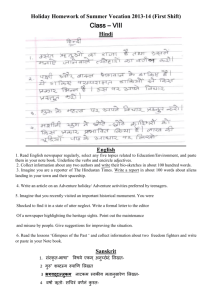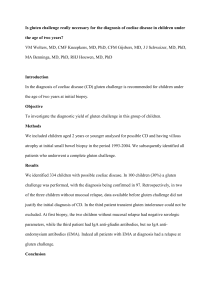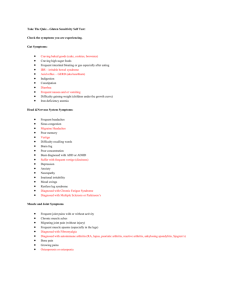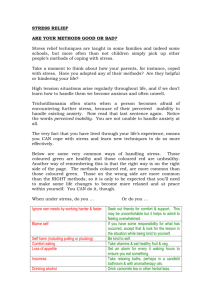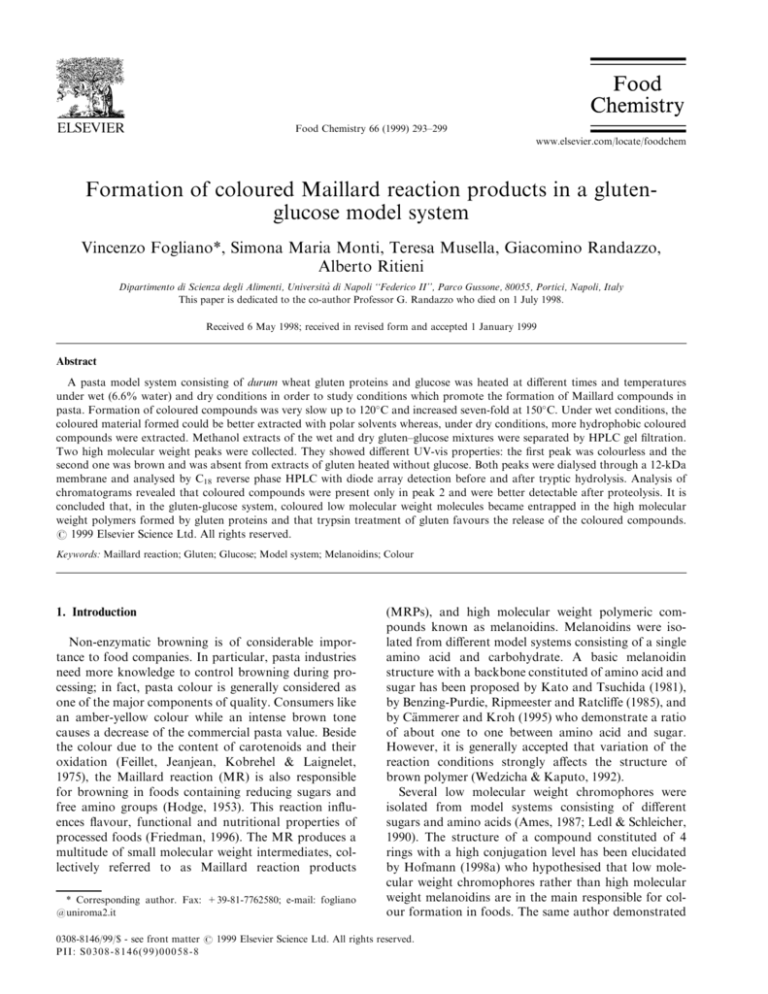
Food Chemistry 66 (1999) 293±299
www.elsevier.com/locate/foodchem
Formation of coloured Maillard reaction products in a glutenglucose model system
Vincenzo Fogliano*, Simona Maria Monti, Teresa Musella, Giacomino Randazzo,
Alberto Ritieni
Dipartimento di Scienza degli Alimenti, UniversitaÁ di Napoli ``Federico II'', Parco Gussone, 80055, Portici, Napoli, Italy
This paper is dedicated to the co-author Professor G. Randazzo who died on 1 July 1998.
Received 6 May 1998; received in revised form and accepted 1 January 1999
Abstract
A pasta model system consisting of durum wheat gluten proteins and glucose was heated at dierent times and temperatures
under wet (6.6% water) and dry conditions in order to study conditions which promote the formation of Maillard compounds in
pasta. Formation of coloured compounds was very slow up to 120 C and increased seven-fold at 150 C. Under wet conditions, the
coloured material formed could be better extracted with polar solvents whereas, under dry conditions, more hydrophobic coloured
compounds were extracted. Methanol extracts of the wet and dry gluten±glucose mixtures were separated by HPLC gel ®ltration.
Two high molecular weight peaks were collected. They showed dierent UV-vis properties: the ®rst peak was colourless and the
second one was brown and was absent from extracts of gluten heated without glucose. Both peaks were dialysed through a 12-kDa
membrane and analysed by C18 reverse phase HPLC with diode array detection before and after tryptic hydrolysis. Analysis of
chromatograms revealed that coloured compounds were present only in peak 2 and were better detectable after proteolysis. It is
concluded that, in the gluten-glucose system, coloured low molecular weight molecules became entrapped in the high molecular
weight polymers formed by gluten proteins and that trypsin treatment of gluten favours the release of the coloured compounds.
# 1999 Elsevier Science Ltd. All rights reserved.
Keywords: Maillard reaction; Gluten; Glucose; Model system; Melanoidins; Colour
1. Introduction
Non-enzymatic browning is of considerable importance to food companies. In particular, pasta industries
need more knowledge to control browning during processing; in fact, pasta colour is generally considered as
one of the major components of quality. Consumers like
an amber-yellow colour while an intense brown tone
causes a decrease of the commercial pasta value. Beside
the colour due to the content of carotenoids and their
oxidation (Feillet, Jeanjean, Kobrehel & Laignelet,
1975), the Maillard reaction (MR) is also responsible
for browning in foods containing reducing sugars and
free amino groups (Hodge, 1953). This reaction in¯uences ¯avour, functional and nutritional properties of
processed foods (Friedman, 1996). The MR produces a
multitude of small molecular weight intermediates, collectively referred to as Maillard reaction products
* Corresponding author. Fax: +39-81-7762580; e-mail: fogliano
@uniroma2.it
(MRPs), and high molecular weight polymeric compounds known as melanoidins. Melanoidins were isolated from dierent model systems consisting of a single
amino acid and carbohydrate. A basic melanoidin
structure with a backbone constituted of amino acid and
sugar has been proposed by Kato and Tsuchida (1981),
by Benzing-Purdie, Ripmeester and Ratclie (1985), and
by CaÈmmerer and Kroh (1995) who demonstrate a ratio
of about one to one between amino acid and sugar.
However, it is generally accepted that variation of the
reaction conditions strongly aects the structure of
brown polymer (Wedzicha & Kaputo, 1992).
Several low molecular weight chromophores were
isolated from model systems consisting of dierent
sugars and amino acids (Ames, 1987; Ledl & Schleicher,
1990). The structure of a compound constituted of 4
rings with a high conjugation level has been elucidated
by Hofmann (1998a) who hypothesised that low molecular weight chromophores rather than high molecular
weight melanoidins are in the main responsible for colour formation in foods. The same author demonstrated
0308-8146/99/$ - see front matter # 1999 Elsevier Science Ltd. All rights reserved.
PII: S0308 -8 146(99)00058 -8
294
V. Fogliano et al. / Food Chemistry 66 (1999) 293±299
that coloured low molecular weight compounds can
cross-link proteins (Hofmann, 1998b).
In wheat-based food, such as pasta, the extent of MR
depends on the intensity of thermal treatment. Yoong,
Walters, Tester, Gomes and Ledward (1994), studying a
gluten carbohydrate model system heated at 160 C for
30 min, reported that brown colour formation paralleled
a loss of free lysine and glutamine.
The ``high temperature process'' of pasta drying is
widely used by companies since it enhances the overall
quality of the ®nal product in terms of ®rmness and
colour (DidoneÁ & Pollini, 1990). However, an uncontrolled MR reduces the nutritional value of wheat protein by lowering the level of nutritionally-available
lysine and causing excessive browning. Many eorts
have been devoted to developing processing conditions
to ®nd a balance between these two opposite tendencies
(DidoneÁ & Pollini, 1990).
In this paper we devised a ``pasta-like'' model system
consisting of durum wheat gluten proteins and glucose in
order to develop a better understanding of the molecular
nature of the coloured compounds formed and to evaluate colour-formation dependence on heating conditions.
2. Materials and methods
All solvents and reagents were of analytical grade and
were supplied by Fluka. HPLC chromatography was
performed on a Shimadzu HPLC apparatus (Japan)
equipped with two LC10 pumps, Reodyne injector and
diode-array detection. Data were processed using Class
M-10 Shimadzu HPLC software.
Absorption spectra of crude MRPs and absorbance
of MR solutions at 420 nm were recorded using a
UV2100 (Shimadzu).
2.1. Model system preparation
A protocol described by Izzo and Ho (1993) was followed with minor modi®cations. Gluten was prepared
by extensive washing under tap water of dough
obtained from durum wheat ¯our variety ``Ferro'' containing 15% proteins. Gluten (10 g) and glucose (2 g)
were added to 30 ml of deionized water. After vigorous
mixing, the sample was freeze dried at 4 C for 48 h. The
solid residue was ®nely ground in a Waring blender,
passed through a sieve and stored desiccated at 4 C. A
control system was prepared by freeze-drying gluten
only.
2.2. Thermal treatments
For the dry system, aliquots (3 g) of gluten±glucose
freeze dried mixture were placed in a glass beaker and
treated in air at 16 dierent time-temperature conditions
as follows: temperatures 80, 100, 120 and 150 C; times
15, 30, 45 and 60 min. The wet system was added to 0.2
ml of deionized water, mixed to give homogeneous
dough, and treated as described above.
2.3. Extraction of coloured material
After heating, 0.5 g of each sample was ®nely ground
and placed in glass tubes. Five dierent solvents (4 ml)
were used for colour extraction: water, methanol, ethanol, acetone and 1 M NaOH. Tubes were hermetically
closed and placed in an orbital shaker. After 1 h, tubes
were centrifuged at 5000g for 10 min. Pellets were discarded and UV-visible spectra of the supernatants were
recorded.
2.4. HPLC separations and trypsin digestion
Methanol extracts were dried under vacuum and resuspended in 1 ml of water. Aliquots of 0.1 ml were
loaded at a ¯ow rate of 1 ml/min on an TSK-gel 2000
SW gel ®ltration column (60-cm length, i.d. 4.6 mm;
TosoHaas, Japan) using deionized water as mobile
phase. Raw data were collected from 200 to 600 nm.
Peaks related to high molecular weight materials, designated as peak 1 and peak 2, were manually collected
and concentrated to 400 ml using a micro®ltration centrifuge ®lter having a cut-o of 12 kDa (Amicon).
Tryptic digestion was performed by adding to 0.1 ml
of samples 50 ml of a 0.1 M carbonate buer, pH 8,
containing 1 mg/ml of trypsin (Sigma). The reaction was
maintained for 12 h at 37 C and then stopped by adding
5 ml of tri¯uoroacetic acid (TFA).
Reverse-phase HPLC was performed on both digested and undigested peaks 1 and 2, collected by gel ®ltration chromatography using a 5m 2504.6 mm C18
column Primesphere 110AÊ (Phenomenex). The column
was equilibrated in 0.1% TFA in water at a ¯ow rate of
1 ml/ min. Elution was achieved by linear gradient from
0 to 98% CH3CN, containing 0.08% TFA in 40 min
and monitored by diode array detection from 200 to 600
nm.
3. Results and discussion
The experimental procedure used allowed the coating
of reducing carbohydrates on the gluten proteins, thus
enhancing strong colour formation upon heating both
in the wet and dry states. This coloured material was
partially extracted with methanol and colour formation
was monitored by UV-vis spectra. A time-course of heat
treatment at 150 C is shown in Fig. 1 where the UV-vis
spectra of methanol extracts from the wet system are
recorded. The ®rst event in colour formation is an
increase in the absorbance at 320 nm (up to 30 min).
V. Fogliano et al. / Food Chemistry 66 (1999) 293±299
295
Fig. 1. UV-Visible spectra of the methanol extract obtained from a wet gluten±glucose model system after dierent times of heating at 150 C:
-.-, time zero; Ð Ð, 15 min, ± ± ±, 30 min, ÐÐ,45 min, Ð ± ± Ð 60 min.
The increase of 420 nm absorbance begins after 30 min
and continues up to 1 h. This behaviour is very similar to
that observed with model systems comprised of one
sugar and one amino acid (Wijewickreme, Kitts & Durance, 1997). The appearance of the absorbance at 320 nm
is due to the formation of soluble pre-melanoidins, while
the absorbance at 420 nm has been used as the end-point
measurement for quantifying the yield of the high molecular weight melanoidins (Wijewickreme et al., 1997).
The 420 nm absorbance, depending on the heating
temperature for the wet gluten±glucose mixture, is
reported in Fig. 2. Colour formation is poor and not
many dierences were detectable for temperatures up to
120 C. A dramatic increase of browning was evident at
150 C. After 45 min, the absorbance at 420 nm is seven
times higher than at 120 C.
The time-course of colour formation in this system
had a similarity to those observed in model systems
made from glucose and free amino acids (Bailey, Ames
& Monti, 1996; Monti, Bailey & Ames, 1998). This evidence was not surprising: in fact, although gluten proteins are rather hydrophobic and do not possess free
Fig. 2. Time course of colour formation in the wet gluten±glucose
system at dierent temperatures. &80 C; ~100 C; !120 C; ^150 C.
Data are representative of ®ve independent sets of experiments. Interexperiment variation was below 5%.
Fig. 3. Absorbance at 420 nm of coloured material extracted after 1 h
using dierent solvents. Shaded bars: wet system; grey bars: dry system. Inset: ratio between absorbance of extracts from wet vs dried
material. Data are representative of three independent sets of experiments. Inter-experiment variation was below 10%.
296
V. Fogliano et al. / Food Chemistry 66 (1999) 293±299
amino acids, at 150 C glutamine residues can undergo
deamidation (Wright, 1991). In fact, it has been reported that free NH3 may be responsible for MRPs formation (Izzo & Ho, 1992; Riha, Izzo & Ho, 1996). The
main dierences between the gluten-glucose and the
single amino acids±glucose model systems is the higher
temperature required by the former to observe the
browning formation (150 C vs 100 C).
Results obtained by Yoong et al. (1994) strengthen
the role played by MR in browning development. They
reported that the heat treatment of dry gluten results in
a loss of 25% of available lysine and of 10% of glutamine residues. The addition of carbohydrates further
increased these values.
In contrast, Clawson and Taylor (1993), based on
chemical changes occurring during cooking of wheat,
concluded that colour formation was only partially due
to the MR while phenolic and lipid oxidation have a
greater in¯uence on colour.
The signi®cant role played by MR in colour formation observed in the gluten±glucose system was con®rmed by the observed dependence of browning on
water activity (Eichner, 1975). Samples heated under
wet conditions produced more colour at all temperatures compared to those heated under dry conditions.
Fig. 3 shows the 420 nm absorbance of materials
extracted using dierent solvents after 1 h of treatment
at 150 C under wet and dry conditions. It is notable
that the absorbance rate was higher for the wet system
when extracted with water and methanol and for the dry
system when extracted with ethanol and acetone. The
inset of Fig. 3 reports the ratio between the amount of
colour extracted from the dry and wet systems: the ratio
is less than one using water and methanol, and more
than one using ethanol and acetone. Data suggest that
less hydrophilic coloured material is formed under dry
conditions.
Extraction with 1 M NaOH (data not shown) resulted
in a complete solubilization of the sample leading to the
formation of brown syrup. This behaviour was probably due to the well-known alkali-solubility of glutenins
(Khan & Bushuk, 1979).
The following step was to investigate the chemical
nature of the extracted coloured material. Dierent
authors (Bailey et al., 1996; CaÈmmerer & Kroh, 1995;
Hayase, Kim & Kato, 1986) have related the development of brown colour to the formation of high molecular weight polymers, called melanoidins. Hofmann
(1998a,b) and Arnoldi, Corain, Scaglioni and Ames
(1997) have elucidated the chemical structures of several
Fig. 4. HPLC gel ®ltration of methanol extract from gluten (control) and gluten±glucose system heated at 150 C. Gluten (- - -); gluten-glucose (Ð)
150. Up: detection at 220 nm; down: detection at 360 nm.
V. Fogliano et al. / Food Chemistry 66 (1999) 293±299
small chromophores formed in dierent amino acid
sugar model systems. Hofmann (1998c), studying a
casein±glucose model system, hypothesised that the
main part of the colour is given by small compounds
which cross-link the reactive side-chain of proteins
forming oligomers. Ames, Arnoldi, Bates and Negroni
(1997), working on a model extrusion-cooked cereal
product (constituted of starch glucose and lysine), isolated 4-hydroxy-2-(hydroxymethyl)-5-methyl-3(2H) furanone and other compounds having a molecular mass
ranging from 250 to 350 Da. These authors reported
that most of the coloured material was not extracted in
methanol but was retained by the starch matrix.
In this framework, it is of interest to investigate what
happens in a pasta-like model system where the MR
occurs in the presence of a protein polymer. Further
experiments work on the methanol extracts, that are
easy to handle and contain large amounts of coloured
compounds, were carried out using samples treated
under wet conditions.
297
HPLC gel ®ltration was performed on the methanol
extracts obtained from samples treated under wet conditions at dierent time-temperatures. Fig. 4 compares
chromatograms obtained after 1 h at 150 C to those of
a control sample (gluten without glucose) at two dierent wavelengths (220 and 360 nm). As expected, low
molecular weight compounds eluted after 20 min constituted most of the extracted material (Hofmann,
1998c). The ®rst peak of the chromatogram (eluted at 10
min) is present also in the control system. It was rather
small in the chromatogram obtained at 360 nm. Therefore, peak 1 did not contribute to the overall colour,
and was likely due to gluten proteins. It is notable that
the high molecular weight material eluted between 11
and 16 min (the ®rst part of which was collected and
indicated as peak 2) parallels the thermal treatments
and shows absorption in the yellow±brown region. The
comparison between chromatograms obtained at intermediate temperature (not shown) demonstrates that the
formation of peak 2 is temperature-dependent.
Fig. 5. HPLC reverse phase analysis with detection at 220 nm of peak 1 and 2 collected from gel ®ltration column as shown in Fig. 4. Panel A: peak
1 without trypsin treatment; Panel B: peak 2 without trypsin treatment; Panel C: Peak 1 after trypsin treatment; Panel D, Peak 2 after trypsin
treatment.
298
V. Fogliano et al. / Food Chemistry 66 (1999) 293±299
The presence of the coloured material in peak 2 could be
explained in three dierent ways: (i) colour is due to high
molecular weight compounds resulting from polymerisation of low molecular weight MRPs formed by glucose and
free ammonia generated by protein deamidation (Rihja et
al., 1996); (ii) reaction of glucose with the side chain of
protein residues leads to the formation of chromophores
covalently linked to gluten proteins as shown by Hofmann
(1998b); (iii) the low molecular weight MRPs formed by
reaction of glucose and free ammonia are incorporated
into the gluten polymer and behave as macromolecules.
To elucidate this point, the two high molecular weight
peaks (1 and 2) obtained from gel ®ltration chromatography were collected, dialysed and concentrated using
a micro®ltration centrifuge ®lter having a cut o of 12
kDa. No coloured material was recovered in the ®ltrate
of either peak, con®rming that non-dialyzable coloured
compounds behave as macromolecules.
After loading the two concentrated peaks on a C18
reverse phase column under denaturing conditions (i.e.
TFA 0.1% and CH3CN), most of the material was not
separated and was eluted as an unresolved broad band
(Panel A and B of Figs. 5 and 6). This chromatographic
behaviour is characteristic of polymeric material (Bailey
et al., 1996). The chromatograms at 360 nm, obtained
for peak 2 (Panel B of Fig. 6), allows observation of
some resolved peaks. This observation suggests that the
chromatographic conditions caused the desorption of
some small compounds from the polymer.
A tryptic hydrolysis was performed on both peaks.
The digested material was again separated by C18
reverse phase under the same conditions as described
above. Results shown in Panels C and D of Figs. 5 and
6 con®rmed that peaks 1 and 2 are mainly proteins. In
fact, chromatograms recorded at 220 nm after trypsin
digestion revealed several peaks probably due to peptides formed by tryptic hydrolysis. This indicates that
methanol extracted coloured material together with
some of the gluten proteins. Among the peaks detectable after proteolysis, only a few, all from peak 2, are
Fig. 6. HPLC reverse phase analysis with detection at 360 nm of peak 1 and 2 collected from gel ®ltration column as shown in Fig 4. Panel A: peak
1 without trypsin treatment; Panel B: peak 2 without trypsin treatment; Panel C: Peak 1 after trypsin treatment; Panel D, Peak 2 after trypsin
treatment. A retention time of the major peaks was reported; F indicates the peak on the front of the chromatogram.
V. Fogliano et al. / Food Chemistry 66 (1999) 293±299
coloured, and detectable at 360 nm (Panels C and D of
Fig. 6). By comparison of the pro®les obtained before
and after proteolysis of peak 2 (cf. Panel B and D of
Fig. 6) it was clear that trypsin treatment did not induce
formation of new compounds. The disruption of gluten
polymers promoted the release of the same compounds
present before proteolysis. In fact, retention times and
UV spectra of the peaks are identical while their amount
is about three times higher.
Trypsin digestion of peak 2 also produced a coloured
peak eluting in front of the chromatographic column
(indicated by ``F'' in Fig. 6, Panel D) which was absent
before proteolysis. The spectrum of peak F is shown in
Fig. 7. This is the only evidence for a coloured compound being directly generated by enzymatic digestion.
It may be due to a peptide-bound chromophore as
envisaged by Clark and Tannenbaum (1970). Further
studies are necessary to ascertain the molecular nature
of this compound.
In conclusion, our results suggest that, in a pasta-like
model system, the presence of high molecular weight
coloured material is mainly due to small MRPs which are
physically entrapped into the gluten proteins polymer.
Acknowledgements
This work was supported by the Commission of the
European Communities, Agriculture and Fisheries
(FAIR) speci®c programme, CT96-1080, ``Optimisation
of the Maillard reaction. A way to improve quality and
safety of thermally processed foods''.
References
Ames, J. M. (1987). A comparison of the colour properties of six heated
sugar/amino acid model systems. Chem. Ind. (London), 659±661.
Ames, J. M., Arnoldi, A., Bates, L., & Negroni, M. (1997). Analysis of
the methanol-extractable non volatile Maillard reaction products of
a model extrusion-cooked cereal product. Journal of Agricultural
and Food Chemistry, 45, 1256±1263.
Arnoldi, A., Corain, E. A., Scaglioni, L., & Ames, J. M. (1997). New
coloured compounds from the Maillard reaction between xylose and
lysine. Journal of Agricultural and Food Chemistry, 45, 650±655.
Bailey, R. G., Ames, J. M., & Monti, S. M. (1996). An analysis of the
non-volatile reaction products of aqueous Maillard model system at
pH 5, using reversed phase HPLC with diode-array detection.
Journal of the Science of Food and Agriculture, 72, 97±103.
Benzing-Purdie, L. M., Ripmeester, J. A., & Ratclie, C. I. (1985).
Eects of temperature on Maillard reaction products. Journal of
Agricultural and Food Chemistry, 33, 31±33.
CaÈmmerer, B., & Kroh, L. W. (1995). Investigation of the in¯uence of
reaction conditions on the elementary composition of melanoidins.
Food Chemistry, 53, 55±59.
Clark, A. V., & Tannenbaum, S. R. (1970). Isolation and characterization of pigments from protein-carbonyl browning system. Journal
of Agricultural and Food Chemistry, 18, 891±894.
299
Clawson, A. R., & Taylor, A. J. (1993). Chemical changes during
cooking of wheat. Food Chemistry, 47, 337±343.
DidoneÁ, G., & Pollini, C. M. (1990). The role of Maillard reaction in
the THT technologies for pasta drying. Tecnica molitoria, 565±572.
Eichner, K. (1975). The in¯uence of water content on non-enzymic
browning reactions in dehydrated foods and model systems and the
inhibition of fat oxidation by browning intermediates. In: R. B.
Duckworth, (Ed.), Proc Int Symp on Water relations of Foods (pp.
417±434). New York: Academic Press.
Feillet, P., Jean, M. F., Kobrehel, K., & Laignelet, B. (1975). Macaroni brownness. Tecnica molitoria, 81±86.
Friedmann, M. (1996). Food browning and its prevention: an overview. Journal of Agricultural and Food Chemistry, 44, 631±653.
Hayase, F., Kim, S. B., & Kato, H. (1986). Analysis of the chemical
structure of melanoidins by 13C NMR, 13C and 15N CP-MAS
NMR. Agricultural and Biological Chemistry, 50, 1951±1957.
Hodge, J. E. (1953). Chemistry of browning reactions in model systems. Journal of Agricultural and Food Chemistry, 46, 2599±2600.
Hofmann, T. (1998a). Characterization of the chemical structure of
novel colored Maillard reaction products from furan-2-carboxaldehyde and amino acids. Journal of Agricultural and Food Chemistry, 46, 932±940.
Hofmann, T. (1998b). 4-Alkylidene-2-imino-5-[4-alkylidene-5-oxo-1,3imidazol-2-inyl]aza-methylidene-1,3-imidazoline. A novel colored
substructure in melanoidins formed by Maillard reaction of bound
arginine with glyoxal and furan-2-carboxaldehyde. Journal of Agricultural and Food Chemistry, 46, 3896±3901.
Hofmann, T. (1998c). Studies on the relationship between molecular
weight and the color potency of fractions obtained by thermal
treatment of glucose/amino acid and glucose/protein solution by
using ultracentrifugation and color dilution techniques. Journal of
Agricultural and Food Chemistry, 46, 3891±3895.
Kato, H., & Tsuchida, H. (1981). Estimation of melanoidin structure
by pyrolysis and oxidation. Progress in Food and Nutritional Science, 5, 147.
Khan, K., & Bushuk, W. (1979). Studies of glutenin. XII. Gel ®ltration, isoelectrofocusing and amino acid composition studies. Cereal
Chemistry, 56, 505±512.
Izzo, H. V., & Ho, C.-T. (1992). Ammonia eects Maillard chemistry
of an extruded autolyzed yeast extract: pyrazine aroma generation
and brown colour formation. Journal of Food Science, 57, 657±659.
Izzo, H. V., & Ho, C.-T. (1993). Eect of residual amide content on
aroma generation and browning in heated gluten-glucose model
systems. Journal of Agricultural and Food Chemistry, 41, 2364±2367.
Ledl, F., & Schleicher, E. (1990). New aspects of the Maillard reaction
in foods and in the human body. Angewante Chemie, 29, 565±594.
Monti, S. M., Bailey, R. G., & Ames, J. M. (1998). A chromatographic
investigation of the in¯uence of pH on the non-volatile reaction products of aqueous Maillard model system by reverse phase HPLC with
diode-array detection. Food Chemistry, 62, 369±375.
Riha, W. E., Izzo, H. V., & Ho, C.-T. (1996). Non-enzymatic deamidation of food proteins. Critical Reviews in Food Science and Nutrition, 36, 225±255.
Yoong, F. S., Walters, R. J., Tester, R. F., Gomes, M. R. A., & Ledward,
D. A. (1994). The role of glutamic acid/glutamine and lysine during
non-enzymic browning in heated gluten. Food Chemistry, 51, 271±274.
Wedzicha, B. L., & Kaputo, M. T. (1992). Melanoidins from glucose
and glycine: composition, characteristics and reactivity towards
sulphite ion. Food Chemistry, 43, 359±367.
Wijewickreme, A. N., Kitts, D. D., & Durance, T. D. (1997). Reaction
conditions in¯uence the elementary composition and metal chelating anity of nondialyzable model Maillard reaction products.
Journal of Agricultural and Food Chemistry, 45, 4577±4583.
Wright, H. T. (1991). Non-enzymatic deamidation of asparaginyl and
glutaminyl residues in proteins. Crit Rev Biochem Mol Biol, 26, 1±51.

